

Rossend Castle is a historic building in Burntisland, a town on the south coast of Fife, Scotland.


Rossend Castle is a historic building in Burntisland, a town on the south coast of Fife, Scotland.
A keep, known as the Tower of Kingorne Wester, was in existence on the site from 1119. It was later referred to as Burntisland Castle, and by 1382 was called Abbot's Hall, as it was the home of the Abbot of Dunfermline. [1] The present building is largely of the 16th century, though with a 13th-century basement, which contains lancet windows and may represent the remains of a chapel. [2] It was rebuilt by Peter Durie of Durie from 1552, and the arms of Abbot George Durie, and the date 1554, appear over the main door. [1]
During the war of the Rough Wooing the English soldier John Luttrell landed at Burntisland on 28 December 1547. He burnt boats and buildings at the pier, and the owners of Rossend surrendered the castle to him. [3]
Mary, Queen of Scots, visited during her short personal reign (1561–1567). On 14 February 1562, the French messenger and poet Chastelard was discovered hiding under Mary's bed in the castle. [4]
On 11 May 1590 Sir Robert Melville hosted the Danish Admiral Peder Munk who was travelling to Falkland Palace to take possession of the lands granted to Anne of Denmark as part of her dowry. [5]
In April 1594 James VI came to Rossend from Leith with his guard, and unsuccessfully tried to capture two rebel supporters of the Earl of Bothwell, Archibald Wauchope of Niddrie and John Wemyss of Logie. [6]
In 1651 it was captured by the soldiers of Oliver Cromwell, and in the later 17th century it was owned by the Wemyss family, who remodelled the top floor.
By 1765, it was owned by Murdoch Campbell, a Highlander from Skye, who probably gave the building its current name. [1]
In 1915 Thomas Ross was arrested whilst studying the castle, for sketching in a prohibited area, and fined five shillings.
The castle was acquired by the Town Council in 1952. In 1957, an early 17th-century painted timber ceiling was discovered; it is now in the National Museum of Scotland in Edinburgh. [1] The ceiling includes the initials 'SRM' for 'Sir Robert Melville of Murdocairney' and emblems copied from the Devises Heroïques of Claude Paradin. [7] The council threatened to demolish the property, which had been allowed to deteriorate, but it was saved after a public inquiry in 1972. It was bought in 1975 by the architecture firm Robert Hurd & Partners, who restored it and retain the building as their offices. It is a category B listed building. [1]
It was bought in 2019 by private owners who have restored it

Burntisland is a former royal burgh and parish in Fife, Scotland, on the northern shore of the Firth of Forth. According to the 2011 census, the town has a population of 6,269. It was previously known as Wester Kinghorn or Little Kinghorn.
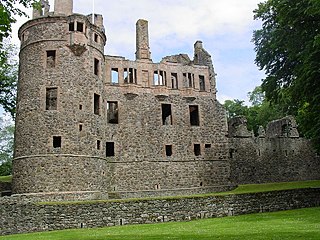
Huntly Castle is a ruined castle north of Huntly in Aberdeenshire, Scotland, where the rivers Deveron and Bogie meet. It was the ancestral home of the chief of Clan Gordon, Earl of Huntly. There have been four castles built on the site that have been referred to as Huntly Castle, Strathbogie Castle or Peel of Strathbogie.

Dunfermline Palace is a ruined former Scottish royal palace and important tourist attraction in Dunfermline, Fife, Scotland. It is currently, along with other buildings of the adjacent Dunfermline Abbey, under the care of Historic Environment Scotland as a scheduled monument.
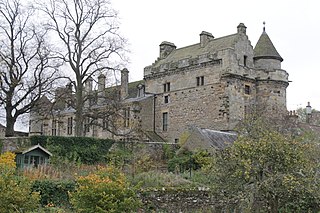
Falkland Palace, in Falkland, Fife, Scotland, is a royal palace of the Scottish Kings. It was one of the favourite places of Mary, Queen of Scots, providing an escape from political and religious turmoil. Today it is under the stewardship of Ninian Stuart, who delegates most of his duties to The National Trust for Scotland. The Chapel Royal in the Palace is dedicated to Thomas the Apostle, and is also open to the public and reserved for Catholic worship.
William Douglas, 6th Earl of Morton was the son of Robert Douglas of Lochleven and Margaret Erskine, a former mistress of James V of Scotland.
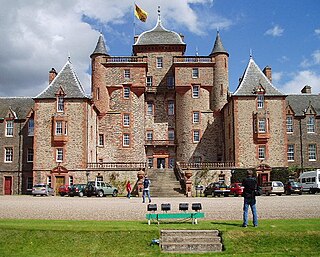
Thirlestane Castle is a castle set in extensive parklands near Lauder in the Borders of Scotland. The site is aptly named Castle Hill, as it stands upon raised ground. However, the raised land is within Lauderdale, the valley of the Leader Water. The land has been in the ownership of the Maitland family since 1587, and Thirlestane served as the seat of the Earls of Lauderdale. The castle was substantially extended in the 1670s by the first and only Duke of Lauderdale. Further additions were made in the 19th century. The castle is now cared for by a charitable trust, and is open to the public.

Dunbar Castle was one of the strongest fortresses in Scotland, situated in a prominent position overlooking the harbour of the town of Dunbar, in East Lothian. Several fortifications were built successively on the site, near the English-Scottish border. The last was slighted in 1567; it is a ruin today.
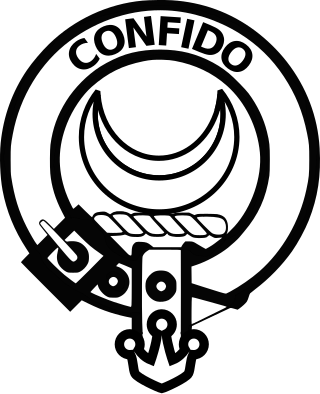
Durie is a Scottish family of the Scottish Lowlands, not a Scottish clan as sometimes reported.

Scottish renaissance painted ceilings are decorated ceilings in Scottish houses and castles built between 1540 and 1640. This is a distinctive national style, though there is common ground with similar work elsewhere, especially in France, Spain and Scandinavia. An example in England, at Wickham, Hampshire, was recorded in 1974. There are records of over 100 examples, and a much smaller number of painted ceilings survive in-situ today. Some salvaged painted beams and boards are stored by Historic Environment Scotland. The paintings at Crathes Castle, dating from 1597 and 1602 are probably the best known.
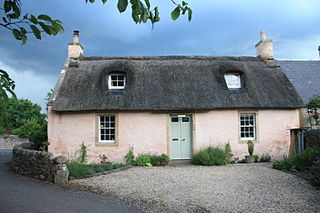
Collessie is a village and parish of Fife, Scotland. The village is set on a small hillock centred on a historic church. Due to rerouting of roads, it now lies north of the A91. Though a railway embankment was constructed through the middle of the village in the 19th century, it retains many of its traditional 17th–18th century houses. In recent years some of the older houses have been re-roofed in traditional thatch.

Jane, Janet, or Jean Kennedy was a companion of Mary, Queen of Scots, during her captivity in England.
Robert Melville, 1st Lord Melville was a Scottish diplomat, administrator, jurist, and intriguer, and uncle of the poet Elizabeth Melville.
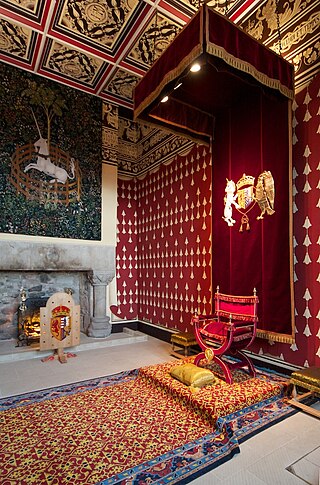
The masque at the baptism of Prince Henry was a celebration at the christening of Prince Henry at Stirling Castle, written by the Scottish poet William Fowler and Patrick Leslie, 1st Lord Lindores.

Peder Munk of Estvadgård (1534–1623), was a Danish navigator, politician, and ambassador, who was in charge of the fleet carrying Anne of Denmark to Scotland. The events of the voyage led to witch trials and executions in Denmark and Scotland.
James Stewart, 1st Lord Doune (1529-1590) was a Scottish landowner.
Sir John Gordon of Lochinvar and Kenmure, was a Scottish courtier, landowner, and supporter of Mary, Queen of Scots.
Sir Robert Douglas of Lochleven was a Scottish courtier and landowner.
George Douglas of Longniddry was a Scottish landowner and courtier.
Archibald Wauchope of Niddrie Scottish landowner and rebel.
John Boswell of Balmuto (1546–1610) was a Scottish landowner and courtier.